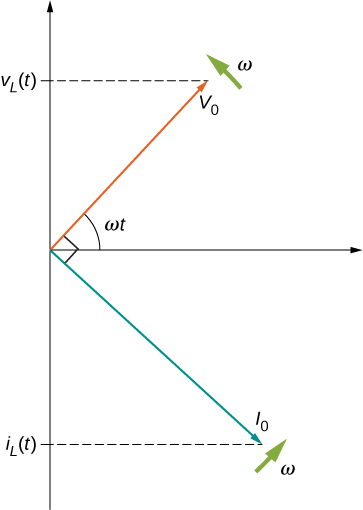| << Chapter < Page | Chapter >> Page > |
where is the peak current in an ac system. The rms voltage , or the root mean square of the voltage, is
where is the peak voltage in an ac system. The rms current appears because the voltage is continually reversing, charging, and discharging the capacitor. If the frequency goes to zero, which would be a dc voltage, tends to infinity, and the current is zero once the capacitor is charged. At very high frequencies, the capacitor’s reactance tends to zero—it has a negligible reactance and does not impede the current (it acts like a simple wire).
Lastly, let’s consider an inductor connected to an ac voltage source. From Kirchhoff’s loop rule, the voltage across the inductor L of [link] (a) is
The emf across an inductor is equal to however, the potential difference across the inductor is , because if we consider that the voltage around the loop must equal zero, the voltage gained from the ac source must dissipate through the inductor. Therefore, connecting this with the ac voltage source, we have

The current is found by integrating this equation. Since the circuit does not contain a source of constant emf, there is no steady current in the circuit. Hence, we can set the constant of integration, which represents the steady current in the circuit, equal to zero, and we have
where The relationship between and may also be written in a form analogous to Ohm’s law:
The quantity is known as the inductive reactance of the inductor, or the opposition of an inductor to a change in current; its unit is also the ohm. Note that varies directly as the frequency of the ac source—high frequency causes high inductive reactance.
A phase difference of rad occurs between the current through and the voltage across the inductor. From [link] and [link] , the current through an inductor lags the potential difference across an inductor by , or a quarter of a cycle. The phasor diagram for this case is shown in [link] .

An animation from the University of New South Wales AC Circuits illustrates some of the concepts we discuss in this chapter. They also include wave and phasor diagrams that evolve over time so that you can get a better picture of how each changes over time.
where is the angular frequency. Since v ( t ) is also the voltage across each of the elements, we have
a. When the amplitude of the current through the resistor is
so
b. From [link] , the capacitive reactance is
so the maximum value of the current is
and the instantaneous current is given by
c. From [link] , the inductive reactance is
The maximum current is therefore
and the instantaneous current is
Check Your Understanding Repeat [link] for an ac source of amplitude 20 V and frequency 100 Hz.
a. ; b. ; c.
Explain why at high frequencies a capacitor acts as an ac short, whereas an inductor acts as an open circuit.
Calculate the reactance of a capacitor at (a) 60 Hz, (b) 600 Hz, and (c) 6000 Hz.
a. ; b. ; c.
What is the capacitance of a capacitor whose reactance is at 60 Hz?
Calculate the reactance of a 5.0-mH inductor at (a) 60 Hz, (b) 600 Hz, and (c) 6000 Hz.
a. ; b. ; c.
What is the self-inductance of a coil whose reactance is at 60 Hz?
At what frequency is the reactance of a capacitor equal to that of a 10-mH inductor?
360 Hz
At 1000 Hz, the reactance of a 5.0-mH inductor is equal to the reactance of a particular capacitor. What is the capacitance of the capacitor?
A resistor is connected across the emf . Write an expression for the current through the resistor.
A capacitor is connected to an emf given by . (a) What is the reactance of the capacitor? (b) Write an expression for the current output of the source.
A 100-mH inductor is connected across the emf of the preceding problem. (a) What is the reactance of the inductor? (b) Write an expression for the current through the inductor.
a. ; b.

Notification Switch
Would you like to follow the 'University physics volume 2' conversation and receive update notifications?